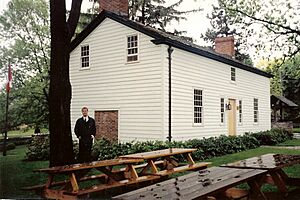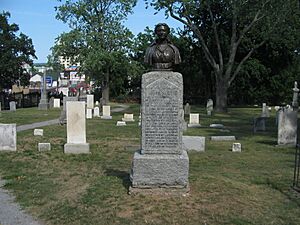Laura Secord facts for kids
Quick facts for kids
Laura Secord
|
|
|---|---|
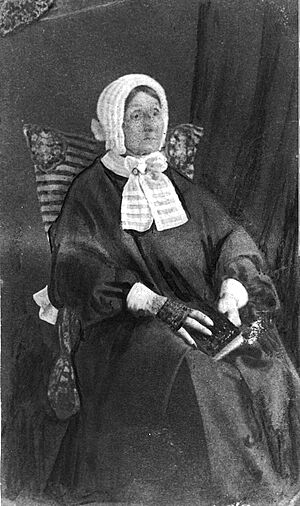
Secord in 1865
|
|
| Born |
Laura Ingersoll
13 September 1775 Great Barrington, Province of Massachusetts Bay
|
| Died | 17 October 1868 (aged 93) Chippawa, Ontario, Canada
|
| Nationality | Canadian |
| Known for | War of 1812 heroine |
| Spouse(s) |
James Secord
(m. 1797; died 1841) |
| Children | 7 |
Laura Secord (born Ingersoll; September 13, 1775 – October 17, 1868) was a brave Canadian woman. She is famous for her actions during the War of 1812. In 1813, she walked about 32 kilometers (20 miles) through American-held land. Her goal was to warn British soldiers about a surprise American attack.
Her heroic act helped the British and their Mohawk allies win the Battle of Beaver Dams. Laura Secord was not widely known during her lifetime. However, after her death, she became a celebrated Canadian hero. Many schools, monuments, and even a chocolate company are named after her.
Contents
Laura Secord's Early Life
Laura Ingersoll was born on September 13, 1775, in Great Barrington, Massachusetts. Her father, Thomas Ingersoll, was a hat maker. He fought for the American side during the American Revolutionary War.
After the war, Thomas Ingersoll moved his family to Upper Canada in 1795. This area is now part of Ontario, Canada. The British Crown was encouraging people to settle there.
Marriage and Family Life
Laura stayed in Queenston, Upper Canada, when her family moved. Around June 1797, she married James Secord. James was a merchant and a United Empire Loyalist. This meant his family had stayed loyal to Britain during the American Revolution.
Laura and James lived in a house in St. Davids, which also had a shop. They had seven children together. Their first child, Mary, was born in 1799. They had four more daughters and one son before the War of 1812 began.
Laura Secord and the War of 1812
The War of 1812 started in June 1812 between the United States and Britain. James Secord joined the local militia to help defend Canada. He was a sergeant in the 1st Lincoln Regiment.
Battle of Queenston Heights
On October 13, 1812, American soldiers crossed the Niagara River. They landed near Queenston. Laura and her five children found shelter in a farmhouse. James went to fight in the Battle of Queenston Heights.
During the battle, James was shot twice. Laura returned to Queenston to find her home had been looted by American soldiers. She heard James was wounded and went to the battlefield. With help, she brought him home and cared for his injuries.
Secord's Famous Walk
In May 1813, the American army captured Fort George. Queenston and the Niagara area were now under American control. Many Canadian men were taken prisoner. James Secord was still recovering from his injuries, so he was not taken.
American soldiers were staying in homes in the area, including the Secords' house. On the evening of June 21, 1813, Laura heard something important. She learned about a secret American plan to attack Lieutenant James FitzGibbon's British troops at Beaver Dams.
Laura knew she had to warn the British. Her husband was still too injured to travel. So, early on June 22, she set out alone. She walked about 32 kilometers (20 miles) through forests and swamps. She passed through several small towns.
Finally, she reached a camp of allied Mohawk warriors. They helped her the rest of the way to FitzGibbon's headquarters. Because of her warning, a small British force and a larger group of Mohawk warriors were ready. They defeated the Americans at the Battle of Beaver Dams on June 24. Many American soldiers were captured.
Life After the War
After the war, the Secord family faced hard times. Their store in Queenston was ruined. They relied on James's small war pension and rent from some land.
Laura and James had two more daughters after the war. Their eldest daughter, Mary, married a doctor and had children. Laura's family grew with many grandchildren.
Struggles and Recognition
James Secord tried to get a government job in 1827. He did not get one, but Laura was offered a position. She was asked to be in charge of the new Brock's Monument. She accepted, but the job was given to another woman.
James Secord died in 1841. Laura was left with very little money. She tried to get a pension for herself, but it was denied. For a short time, she ran a small school from her home to earn money.
In 1860, when Laura was 85 years old, the Prince of Wales visited Canada. He heard her story and learned about her difficult situation. He gave her £100 as a special award. This was the only official recognition she received during her lifetime.
Laura Secord died in 1868 at the age of 93. She was buried next to her husband in Drummond Hill Cemetery in Niagara Falls. Her grave has a monument with a bust of her.
The inscription on her grave marker tells her story:
To perpetuate the name and fame of Laura Secord, who walked alone nearly 20 miles by a circuitous difficult and perilous route, through woods and swamps and over miry roads to warn a British outpost at DeCew's Falls of an intended attack and thereby enabled Lt. FitzGibbon on 24 June 1813, with fewer than 50 men of the H.M. 49th Regt., about 15 militiamen and a small force of Six Nations and other Indians under Capt. William Johnson Kerr and Dominique Ducharme to surprise and attack the enemy at Beechwoods (or Beaver Dams) and after a short engagement, to capture Col. Bosler of the U.S. Army and his entire force of 542 men with two field pieces.
Laura Secord's Legacy
Laura Secord's story has become a very important part of Canadian history. She is often seen as a symbol of courage and determination.
How Her Story Grew
At first, FitzGibbon's reports of the battle did not mention Laura Secord. He only said he "received information." Later, he wrote certificates supporting her claim. Some historians have debated the exact details of her walk. However, her bravery and effort are widely recognized.
Her story became very popular in the late 1800s. Women who wanted more rights for women saw her as a perfect heroine. Books, plays, and poems were written about her. She has been compared to other famous heroes like Paul Revere.
Honours and Memorials
In 1901, a granite monument was built in Queenston Heights to honour Laura Secord. In 1905, her portrait was hung in the Canadian Parliament.
In 1913, on the 100th anniversary of her walk, the Laura Secord Chocolates company was founded. It was named after her to celebrate Canadian patriotism. Today, many Canadians know her name because of the chocolate company.
The Secords' old home in Queenston was restored and is now a museum. The Laura Secord Legacy Trail follows the 32-kilometer route of her famous walk.
Laura Secord has many schools named after her across Canada. These include schools in Queenston, Winnipeg, St. Catharines, and Vancouver. In 1992, Canada Post issued a stamp with her image.
In 2003, she was declared a "Person of National Historical Significance." In 2006, a statue of Laura Secord was placed at the Valiants Memorial in Ottawa. To mark the 200th anniversary of her walk, her image was put on a Canadian quarter and another postage stamp.
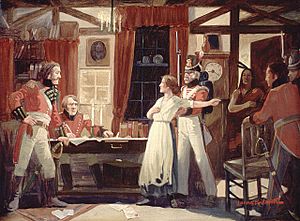

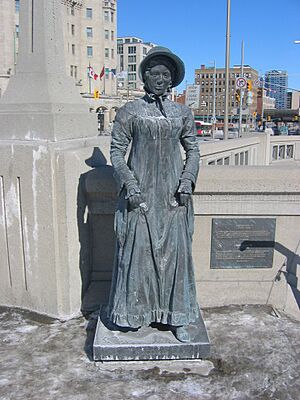

See also


